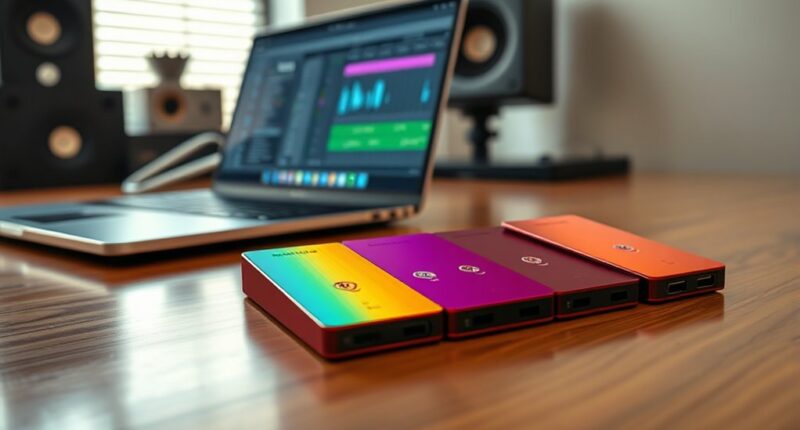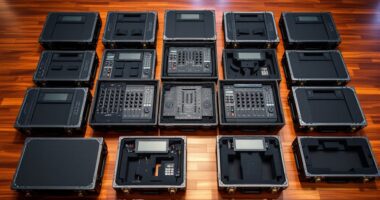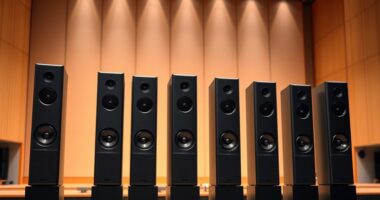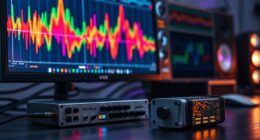If you’re looking for the best SSDs for DAW sessions in 2025, I recommend considering high-speed NVMe options like the Lexar NM790 and Predator GM7000, along with reliable SATA drives like the PNY CS900. These drives offer fast read/write speeds, strong durability, and broad compatibility for desktops, laptops, or NAS setups. Staying within your budget and ensuring proper thermal management will boost your workflow. Keep exploring to find the perfect match for your needs.
Key Takeaways
- High-speed NVMe SSDs like Lexar NM790 and Predator GM7000 deliver read/write speeds above 7400MB/s for seamless DAW performance.
- Ensure SSD compatibility with your system’s interface (M.2 PCIe or SATA) and form factor (2280) for easy installation.
- Prioritize SSDs with effective thermal management and durability features to maintain consistent performance during intensive sessions.
- Consider capacity and TBW ratings to future-proof your storage and ensure long-term reliability for large projects.
- Additional features such as heatsinks, security options, and NAS support enhance performance, data security, and workflow flexibility.
Lexar 1TB NM790 SSD with Heatsink PCIe Gen4 NVMe M.2 2280

Are you looking for a high-performance SSD that can handle demanding digital audio workstation (DAW) sessions without breaking a sweat? The Lexar 1TB NM790 SSD with Heatsink is a top choice. It features PCIe Gen4 NVMe technology, delivering blazing speeds up to 7400MB/s read and 6500MB/s write. Its built-in heatsink keeps temperatures in check during intense workloads, ensuring consistent performance. Compatible with desktops, laptops, and PS5, it’s perfect for audio editing, large sample libraries, and multitasking. Plus, with a durable design, low power consumption, and a five-year warranty, it’s reliable for professional studio setups or serious hobbyist work.
Best For: professionals and hobbyists seeking high-speed, reliable storage for demanding digital audio workstations, gaming, or large file management.
Pros:
- Exceptional read/write speeds up to 7400MB/s and 6500MB/s, ensuring fast data transfer and efficient workflows
- Built-in heatsink maintains optimal thermal performance during intensive tasks
- Compatible with desktops, laptops, and PS5, offering versatile installation options
Cons:
- Higher price point compared to standard SSDs with lower performance levels
- Limited to M.2 2280 slot compatibility, restricting some older systems
- Potential overkill for users with simple storage needs or less demanding applications
PNY CS900 500GB SATA III Internal SSD
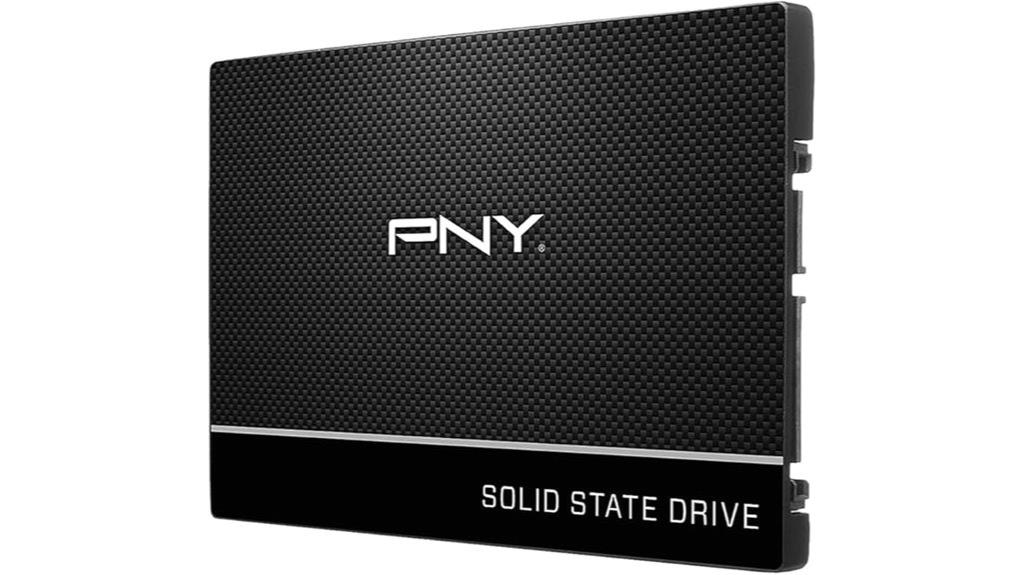
The PNY CS900 500GB SATA III Internal SSD is an excellent choice for music producers and audio engineers seeking faster DAW sessions, thanks to its impressive read and write speeds. It offers up to 550MB/s sequential read and 500MB/s sequential write speeds, notably improving system responsiveness and project load times over traditional HDDs. Its compatibility with SATA II interfaces ensures broad device support, while 3D NAND technology enhances durability and reliability. Additionally, its ultra-low power consumption helps extend battery life, making it a practical upgrade for both desktops and laptops. Overall, the PNY CS900 provides a reliable, high-performance storage solution for demanding audio workflows.
Best For: music producers and audio engineers seeking faster DAW sessions, improved system responsiveness, and reliable storage for demanding audio workflows.
Pros:
- Fast sequential read/write speeds of up to 550MB/s and 500MB/s, enhancing performance
- Broad compatibility with SATA II and III interfaces for versatile device support
- Durable with 3D NAND technology and low power consumption for extended reliability and battery life
Cons:
- Limited to 500GB capacity, which may be insufficient for very large audio project libraries
- No included software or encryption features for additional data security
- May require technical knowledge for installation in some systems
Predator M.2 SSD 512GB GM7000 with DRAM Cache NVMe 1.4 2280 PCIe Gen4×4

For anyone working on digital audio workstation (DAW) projects, the Predator M.2 SSD 512GB GM7000 stands out thanks to its blazing NVMe 1.4 PCIe Gen4×4 speeds and reliable DRAM cache. It delivers sequential read speeds up to 7400MB/s and write speeds up to 6700MB/s, ensuring rapid project loading and smooth playback. Its compact M.2 2280 form factor makes installation effortless across PCs, laptops, and consoles like PS5 Pro. Built with 3D NAND TLC and an effective heat spreader, it maintains lower temperatures under load, while the 5-year warranty guarantees long-term durability for demanding DAW sessions.
Best For: content creators, gamers, and professionals working with large files or demanding applications like digital audio workstations (DAW).
Pros:
- Exceptional sequential read/write speeds up to 7400MB/s and 6700MB/s, reducing load times
- Reliable DRAM cache and durable 3D NAND TLC for long-term performance and endurance
- Compact M.2 2280 form factor compatible with a wide range of devices including PCs, laptops, and PS5 Pro
Cons:
- Can run warmer than comparable drives, requiring proper thermal management
- Installation may be complicated when using large heatsinks or in systems with limited space
- Higher cost compared to SATA SSDs with similar capacities, though justified by performance
SonicWall TZ400 Network Security Appliance 01-SSC-0213

If you’re managing a small office or home network that demands robust security, the SonicWall TZ400 Network Security Appliance is an excellent choice. It offers strong protection with SonicOS 6.x and supports wireless 802.11ac. Compact yet powerful, it’s designed for small business environments, ranking well among top-selling routers. While setup can be complex and support requires additional licensing, it provides reliable network security. Customer reviews are generally positive, highlighting its effectiveness for SOHO use. However, it’s more suited for users with technical support resources, given its advanced features and slightly higher cost. Overall, the TZ400 balances security, performance, and professional-grade management.
Best For: small office or home office environments requiring advanced network security with professional management features.
Pros:
- Provides robust security with SonicOS 6.x and wireless support for 802.11ac.
- Compact design suitable for small spaces while offering powerful network protection.
- Recognized as a top-selling device with positive customer reviews and reliable performance.
Cons:
- Setup can be complex and may require technical expertise or additional support licenses.
- No included support; tech assistance is available only with a separate purchase of licensing.
- Higher cost compared to standard routers, which may be a concern for budget-conscious users.
Synology DiskStation DS420+ NAS Server

Are you looking for a reliable NAS that can handle intensive multi-user workloads and provide ultra-fast storage for your DAW sessions? The Synology DiskStation DS420+ is an excellent choice. It features a powerful Celeron J4025 dual-core processor and 6GB of DDR4 RAM, supporting high-capacity storage up to 72TB with multiple HDDs. Its support for M.2 NVMe SSDs allows for caching, boosting speed for demanding tasks. With dual Gigabit LAN ports, link aggregation, and advanced security features, it ensures fast, secure access. Perfect for small to medium studios, it offers scalable, versatile storage solutions tailored to your evolving needs.
Best For: small to medium-sized studios and businesses seeking a high-capacity, scalable NAS with fast storage and robust security features for multi-user workloads.
Pros:
- Powerful Celeron J4025 dual-core processor with 6GB DDR4 RAM for smooth multi-tasking
- Support for up to 72TB storage with multiple HDDs and M.2 NVMe SSD caching options for enhanced speed
- Dual Gigabit LAN ports with link aggregation and failover for reliable, fast network connectivity
Cons:
- Hard drives and memory upgrades are sold separately and require installation
- Limited to 2.9GHz burst speed, which may be insufficient for extremely intensive workloads
- No built-in 10GbE ports, potentially limiting maximum network speed in high-demand environments
Factors to Consider When Choosing SSDS Compatible With DAW Sessions
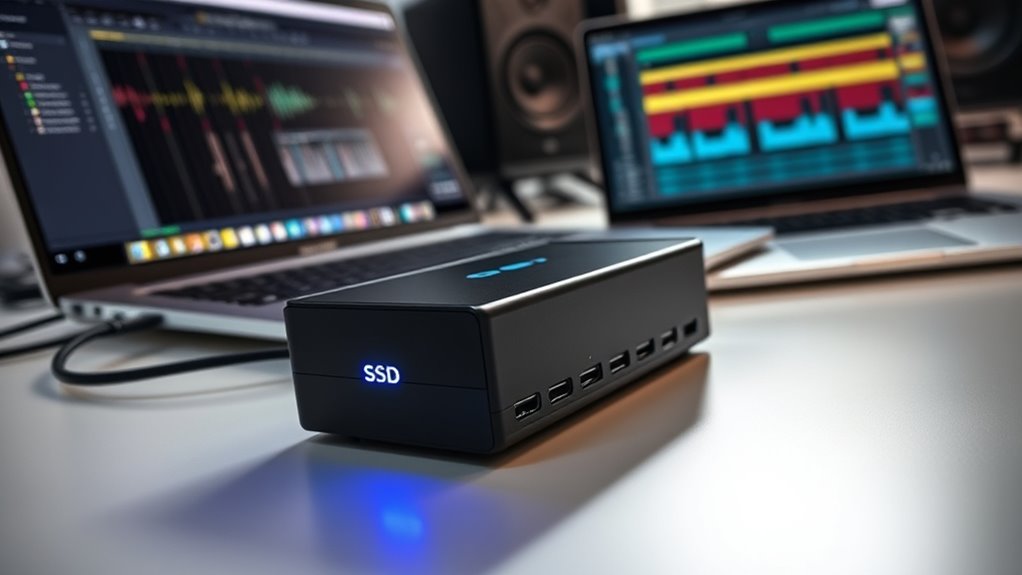
When choosing an SSD for your DAW sessions, I consider factors like storage capacity, read/write speeds, and compatibility with my software. It’s also important to think about thermal management and power consumption to guarantee reliable performance. By paying attention to these points, you can select an SSD that keeps your workflow smooth and efficient.
Storage Capacity Needs
Choosing the right storage capacity for your SSD is essential to guarantee smooth DAW sessions, especially as project sizes and complexity grow. Start by estimating the size of your current projects, including audio recordings, plugin data, and sample libraries. Think ahead about future needs—larger projects or more sessions will require more space. Consider your workflow’s demands, like high-resolution audio files or extensive sample libraries, which can quickly fill up storage. Also, account for the number of virtual instruments or simultaneous sessions, ensuring your SSD can handle multiple data streams without bottlenecks. While larger capacities often come at a higher cost, they also offer better performance and future-proofing, making them a smart investment in the long run.
Read/Write Speed Requirements
To guarantee your DAW sessions run smoothly, prioritizing high read and write speeds on your SSD is vital. Speeds over 500MB/s ensure seamless playback and recording without hiccups. If your SSD has sequential read speeds above 7,000MB/s, it can drastically cut project load times and boost workflow efficiency. Faster write speeds are essential during real-time recording, helping to prevent dropouts and glitches that disrupt audio quality. High-speed performance also reduces latency in large multi-track sessions, keeping everything running smoothly. Ultimately, choosing an SSD that exceeds your DAW’s demands ensures reliable, efficient performance, especially when handling complex projects. Prioritizing read/write speeds helps you work more confidently, knowing your hardware can keep up with your creative process.
Compatibility With DAW
Selecting an SSD that’s compatible with your DAW setup requires careful attention to several key factors. First, verify the SSD supports the right interface, like NVMe PCIe Gen4 or SATA III, matching your motherboard or laptop. Next, confirm the form factor—M.2 2280 is common, but it must fit your workstation’s slots or bays. Check the read and write speeds to handle large audio and video files smoothly. It’s also essential to review the endurance rating (TBW) and warranty, ensuring reliability during intense sessions. Finally, consider thermal management features such as heatsinks or cooling solutions to prevent performance throttling. Compatibility isn’t just about speed but also about seamless integration, stability, and durability in your DAW environment.
Thermal Management Solutions
Since DAW sessions often involve prolonged periods of high-speed data transfers, guaranteeing proper thermal management for your SSD is essential. Overheating can cause thermal throttling, which reduces performance and risks audio dropouts or latency. SSDs with built-in heatsinks or enhanced thermal dissipation features are ideal for demanding workflows, especially when working with large session files. Maintaining good airflow within your case or enclosure helps dissipate heat effectively, preventing thermal buildup. Using software tools to monitor SSD temperatures allows early detection of thermal issues, so you can make adjustments as needed. Proper thermal management ensures your SSD stays within optimal operating temperatures, maintaining consistent performance and preventing interruptions during critical audio production sessions.
Power Consumption Levels
When choosing an SSD for your DAW session, paying attention to power consumption levels can make a significant difference in overall performance and reliability. Lower power consumption extends battery life in portable setups, so you can work longer without recharging. It also reduces heat generation, which helps maintain thermal stability during intensive recording or mixing sessions. Less heat means less need for cooling, resulting in quieter operation and improved studio acoustics. Energy-efficient SSDs generally put less electrical stress on your system, potentially increasing the drive’s lifespan. Specifications often indicate power usage, with some models consuming up to 40% less energy than comparable options. Prioritizing power consumption levels ensures a smoother, more reliable experience, especially when working on portable or energy-conscious systems.
Endurance and Lifespan
Endurance and lifespan are critical considerations when choosing an SSD for your DAW sessions because these drives handle a significant amount of data over time. SSD endurance is measured in terabytes written (TBW), showing how much data can be written before the drive might start to fail. Higher TBW ratings usually mean a longer lifespan, making them ideal for continuous use in audio production. Professional-grade drives often exceed 1000TBW, offering durable performance for demanding workloads. Regularly monitoring SSD health via SMART data helps detect potential issues early, extending the drive’s useful life. Additionally, selecting drives with robust NAND technology, like 3D NAND, boosts durability and maintains high-speed performance during intensive tasks. Prioritizing endurance guarantees your DAW setup remains reliable, even during long, demanding sessions.
Form Factor Compatibility
Choosing an SSD that fits your DAW setup starts with verifying its form factor compatibility. First, check that the physical size matches your device’s slot, like M.2 2280 for most modern laptops and desktops. Confirm that your motherboard supports the specific form factor, whether M.2, 2.5-inch SATA, or PCIe add-in cards. It’s also essential to verify the interface is compatible—NVMe for M.2 slots or SATA III for 2.5-inch drives—to guarantee proper connection. Don’t forget to validate the SSD’s dimensions and heatsink options, especially in compact or sealed enclosures, to avoid fitting issues. Ultimately, ensure your BIOS or firmware supports booting or working with that form factor, so your DAW sessions run smoothly without hardware hiccups.
Cost and Budget
Selecting the right SSD for your DAW sessions involves balancing your budget with performance needs. SSD prices vary widely, with larger capacities and faster speeds costing more. Budget-friendly options might seem appealing but may offer slower performance or lower endurance, which can impact your workflow over time. Investing in a higher-end SSD with faster read/write speeds can markedly improve project load times and reduce latency during recording and mixing. Features like heatsinks or DRAM cache usually increase costs but help maintain consistent performance during intensive sessions. It’s crucial to find a balance—overspending on an SSD might be unnecessary for basic tasks, while under-investing could hinder your workflow. Consider your project complexity and long-term needs to choose an SSD that offers the best value.
Frequently Asked Questions
How Do SSDS Impact Real-Time Audio Processing Latency?
SSDs substantially reduce real-time audio processing latency because they offer faster read and write speeds compared to traditional HDDs. This means I experience less delay when recording or editing, resulting in smoother playback and more accurate monitoring. Their quick data access helps prevent dropouts and glitches, ensuring my DAW runs efficiently. Overall, upgrading to a high-quality SSD improves my workflow by making real-time audio processing more responsive and reliable.
Are There Specific SSD Brands Recommended for Long-Term DAW Reliability?
Absolutely, I recommend brands like Samsung, Crucial, and Western Digital for long-term DAW reliability. I’ve found Samsung’s SSDs, especially the 980 Pro and 870 Evo, to be consistently dependable and fast. Crucial’s MX500 series offers great value, and Western Digital’s Black SN850 is excellent for high-performance tasks. These brands have proven durability, compatibility, and solid support, which are essential for maintaining smooth, trouble-free audio sessions over time.
Can SSDS Be Used Simultaneously for Multiple DAW Projects?
Yes, you can use multiple SSDs simultaneously for multiple DAW projects. I do this often to keep session data separate and avoid bottlenecks. Just make sure your computer has enough ports and bandwidth to handle multiple drives efficiently. Using separate drives for different projects enhances performance and reduces the risk of data loss. It’s a smart way to stay organized and maintain fast, reliable access during complex recording sessions.
What Is the Optimal SSD Lifespan for Professional Audio Production?
In my experience, an SSD’s ideal lifespan for professional audio production is around 5 to 7 years. I once upgraded my studio’s drives after five years of heavy use, noticing slight slowdowns. Modern SSDs typically last longer, thanks to wear-leveling and error correction. Regular backups and monitoring drive health help extend their life, ensuring reliable performance for complex projects without risking data loss.
Do SSDS Require Special Cooling for Sustained High-Performance in DAW Use?
No, SSDs generally don’t need special cooling for sustained high-performance in DAW use. Modern SSDs are designed to handle heat efficiently, but ensuring proper airflow in your setup helps prevent thermal throttling during intense sessions. I recommend keeping your workspace well-ventilated and avoiding enclosed cases that trap heat. This way, your SSDs stay cool, perform ideally, and last longer without the need for extra cooling solutions.
Conclusion
Choosing the right SSD can transform your DAW sessions from sluggish to lightning-fast. With options like the Lexar NM790 and Predator GM7000, you’ll experience speeds that feel almost supernatural, making your workflow smoother than ever. Remember, the perfect drive isn’t just about speed—it’s about reliability and compatibility. Invest wisely, and you’ll stay ahead of the game, turning your studio into a powerhouse where creativity flows at the speed of light.
